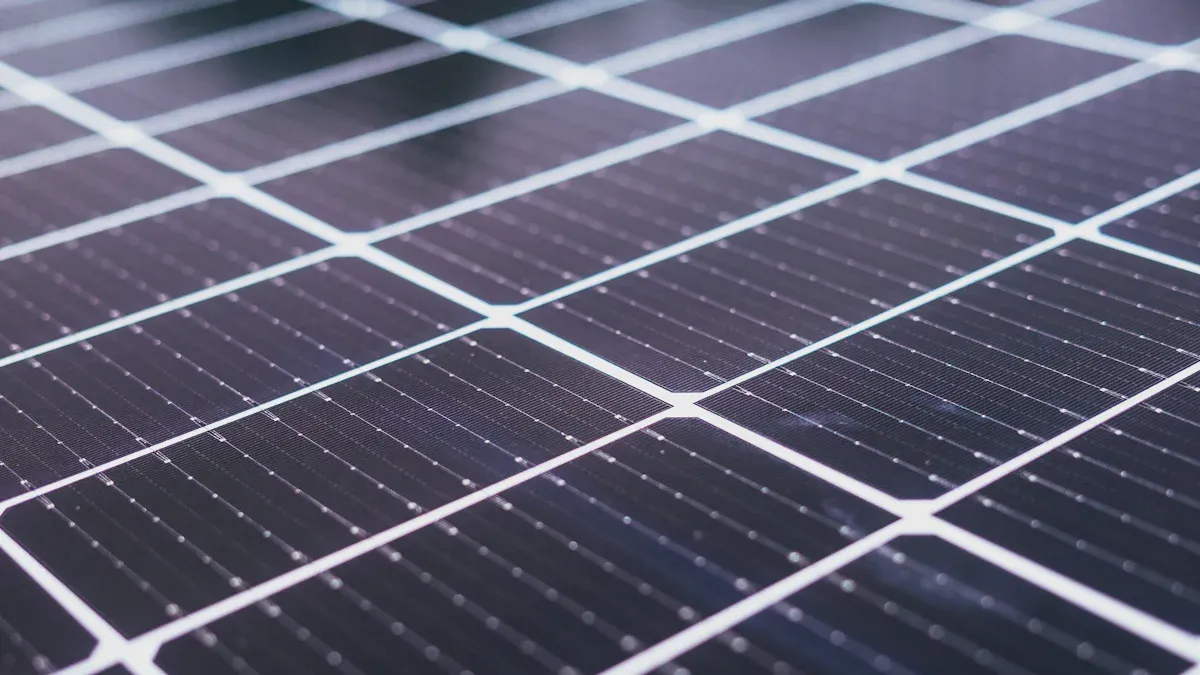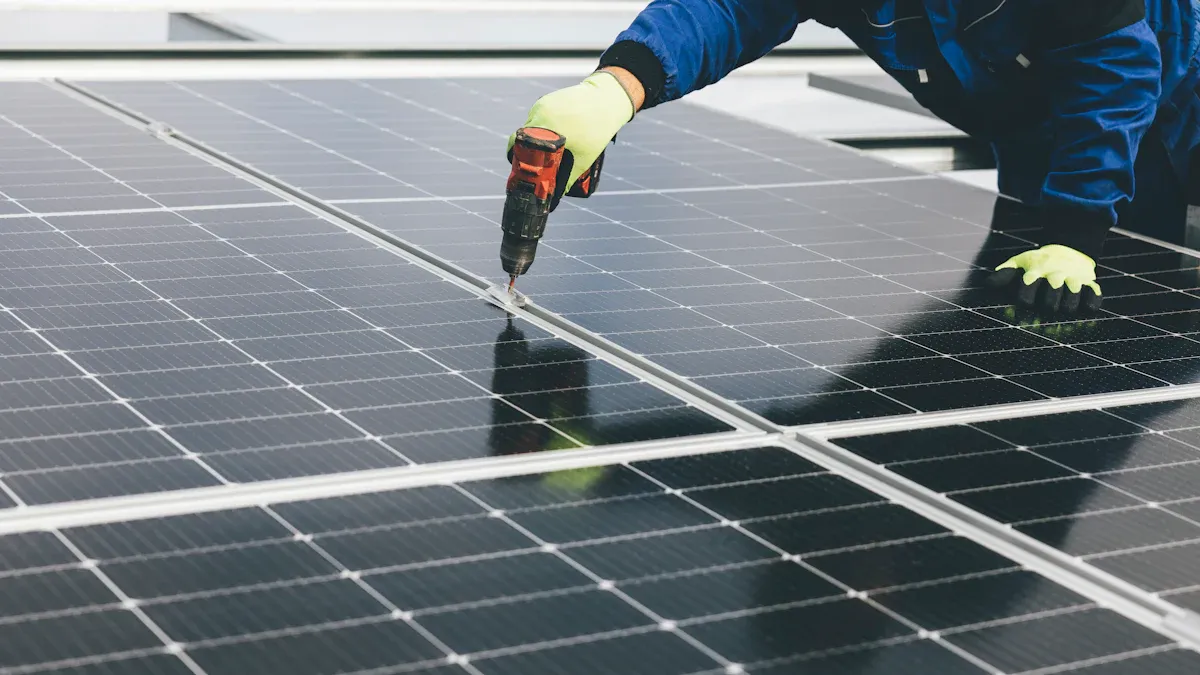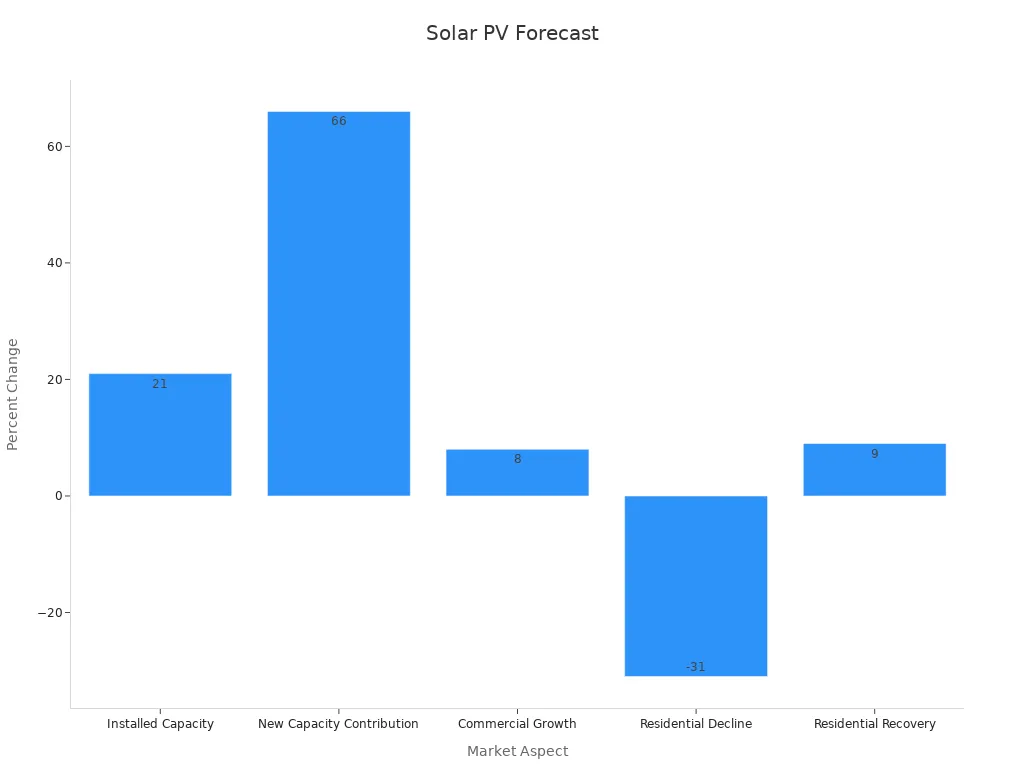Top Trends in Long-Lasting PV Structure Technology by ESTEL

Long-lasting PV structures play a vital role in the future of solar energy, ensuring durability and efficiency for decades. As global energy demand is set to rise by 50% within the next 20 years, you can rely on solar energy to meet sustainability goals while reducing carbon footprints. Countries like Australia, Japan, and Germany demonstrate high adoption rates, with millions of solar systems already installed. These advancements highlight the importance of robust designs that withstand environmental challenges and optimize energy production. ESTEL continues to lead the way, offering innovative solutions for reliable and efficient solar infrastructure.
Key Takeaways
New materials like perovskite and multi-layer cells make solar panels work better. They can turn over 25% of sunlight into energy. This gives you more power for your money.
Using smart tools, like real-time monitoring, improves how solar panels work. It also lowers repair costs and keeps them running well.
Strong designs protect solar panels from bad weather. This helps them last longer and work better in tough conditions.
Recycling old solar panels cuts down on trash and saves materials. This helps the planet and supports clean energy goals.
Spending on better monitoring tools can cut downtime by 70%. This means more energy and longer-lasting solar panels.
Key Innovations in Long-Lasting PV Structure Technology

Advanced Materials for Long-Lasting PV Structure
The materials used in photovoltaic (PV) structures determine their durability and efficiency. You can rely on advanced materials to enhance the lifespan of solar panels while boosting energy output. Studies on vertical bifacial photovoltaic systems reveal remarkable efficiency improvements due to innovative materials and designs. These systems achieve daily power output increases of up to 26.91% compared to conventional tilted systems, showcasing the transformative impact of advanced materials on energy production.
Modern solar panel technology incorporates cutting-edge materials like perovskite and multi-junction cells, which improve conversion efficiency. Panels now achieve rates exceeding 20%, with some reaching as high as 25%. Trina Solar recently set a world record with a conversion efficiency of 25.44%, demonstrating the rapid pace of solar PV module innovations. Additionally, materials like Tedlar®-based backsheets exhibit exceptional durability, maintaining reliability for over 35 years under thermal stress and UV exposure. These advancements ensure that your solar panels remain efficient and safe for decades.
Smart Integration in Solar Panel Technology
Smart integration is revolutionizing solar panel technology, making systems more efficient and adaptable. You can benefit from innovations like tandem cells, bifacial panels, and transparent solar cells, which optimize energy capture and utilization. Flexible PV designs allow installations on unconventional surfaces, expanding the scope of renewable energy applications.
Emerging technologies also focus on intelligent monitoring and control systems. These systems enable real-time performance tracking, ensuring that your solar panels operate at peak efficiency. By integrating smart features, solar PV module innovations reduce maintenance costs and improve energy output. This trend highlights the importance of combining advanced materials with intelligent design to maximize the benefits of solar energy.
Weatherproof Designs for Extreme Conditions
Weatherproof designs are essential for ensuring the longevity of PV structures in harsh environments. You can trust these designs to withstand extreme weather events like hailstorms and high winds. Studies show that hail sizes of 25mm or greater significantly impact performance loss rates (PLR), while wind speeds above 90 km/hour create threshold effects on system reliability. Advanced weatherproofing minimizes these losses, safeguarding your investment in renewable energy.
Modern PV structures incorporate durable materials and innovative designs to resist environmental stress. For example, encapsulation materials like ethylene vinyl acetate copolymer (EVA) and polyolefins (PO) enhance durability. Cross-linking agents further improve resilience, ensuring that your panels perform reliably even under extreme conditions. These advancements reflect the latest solar panel technology trends, emphasizing the importance of durability and adaptability in renewable energy systems.
Market Trends Shaping Solar PV Module Innovations
Growth in Utility-Scale Solar Projects
Utility-scale solar projects are transforming the renewable energy landscape. Over the past decade, the total solar capacity has grown from 15.1 GW in 2014 to 121 GW in 2023. Electricity generation from solar has increased eightfold during this period, reaching 4.0 TWh. Utility-scale solar capacity alone has expanded from 5.0 GW to 40.0 GW, now accounting for 8% of total electricity capacity.
Large corporations are driving this growth by signing power purchase agreements to meet clean energy goals. Companies like Google and Amazon are investing heavily in utility-scale solar installations to reduce their carbon footprints. This trend highlights the importance of photovoltaic innovations in meeting global energy demands.
Policy Incentives Driving Solar Adoption
Government policies play a pivotal role in accelerating solar energy adoption. Incentives like feed-in tariffs (FIT), tax credits, and research grants have proven effective in boosting renewable energy projects. For example, FIT policies have significantly increased solar installations in countries like Germany and Japan. Tax credits in the U.S. have made solar panels more affordable for residential and commercial users.
A study analyzing policy impacts found that R&D incentives and FIT policies had a statistically significant positive effect on solar energy adoption. These measures encourage innovation in photovoltaic technology, making solar energy more competitive with traditional sources.
Competitive Dynamics in the Solar Industry
The solar industry is highly competitive, with major players like Trina Solar, First Solar, and JinkoSolar leading the market. Between 2022 and 2032, quantitative analyses predict significant growth driven by cost reductions, technological advancements, and environmental concerns.
Chinese firms have gained a competitive edge through upstream network relationships, enabling them to dominate the global photovoltaic market. In contrast, Western firms focus on downstream innovations like smart grid technology and battery storage. This dynamic fosters continuous growth and innovation in solar energy solutions.

Sustainability and Longevity in Solar Panel Technology

Eco-Friendly Practices in Solar PV Module Innovations
Eco-friendly practices in solar PV module innovations are transforming the renewable energy landscape. By adopting sustainable manufacturing processes, you can reduce the environmental impact of solar panels while maintaining their efficiency and durability. Lifecycle assessments (LCAs) of photovoltaic systems reveal that modern technologies like PERC (Passivated Emitter and Rear Cell) significantly lower greenhouse gas emissions and energy consumption compared to traditional Al-BSF (Aluminum Back Surface Field) technology. These advancements ensure that solar panels contribute to clean energy generation without compromising sustainability.
Manufacturers are also prioritizing the use of non-toxic materials and energy-efficient production methods. For example, PERC technology, when combined with horizontal single-axis tracker systems, demonstrates reduced resource depletion and energy use. These innovations highlight the importance of integrating eco-friendly practices into every stage of solar panel production, from design to disposal.
Tip: Choosing panels made with sustainable materials not only supports renewable energy goals but also ensures long-term environmental benefits.
Recycling and Circular Economy in Solar
Recycling and circular economy practices are essential for managing the end-of-life phase of solar panels. With millions of panels reaching the end of their lifespan, you can play a crucial role in reducing waste by supporting recycling initiatives. A critical review of circular economy practices emphasizes the need for sustainable module design and efficient recycling methods. Advances in recycling technology focus on improving material recovery rates and purity, ensuring that valuable components like silicon, silver, and aluminum are reused effectively.
Recoverable Material | Module Weight | Recovery Rate |
|---|---|---|
Estimated Amount | 18.5 kg | FRELP rates |
These efforts align with global sustainability goals, promoting a closed-loop system where materials from old panels are repurposed for new ones. By adopting these practices, the solar industry can minimize its environmental footprint while enhancing the durability of PV systems.
Key benefits of recycling solar panels include:
Reduced landfill waste.
Conservation of raw materials.
Lower production costs for new panels.
Enhancing Long-Term Performance of Solar Systems
Enhancing the long-term performance of solar systems ensures that your investment in renewable energy delivers maximum returns. Advanced monitoring and maintenance technologies now allow you to track energy output and detect faults in real time. This proactive approach reduces downtime by up to 70% and lowers maintenance costs by 25%.
Key Performance Indicator | Improvement Description |
|---|---|
Energy Yield | Increased by 3-8% annually through data-driven monitoring |
Maintenance Costs | Reduced by up to 25% due to proactive maintenance scheduling |
Downtime | Reduced by up to 70% through early fault detection |
Energy Generation | Improved by 2-5% with optimized cleaning schedules |
Payback Period | Achieved in 12-18 months on analytical infrastructure investments |
Durability remains a cornerstone of solar panel technology. Rigorous testing, such as salt spray and hail impact tests, confirms that modern panels withstand harsh conditions with minimal degradation. For instance, panels maintain structural integrity after 96 hours of salt spray exposure and resist hail impacts from ice balls traveling at 23 m/s. These findings demonstrate the reliability of solar systems in diverse environments, from coastal areas to arid deserts.
By combining durable materials, intelligent monitoring, and efficient recycling, you can ensure that solar panels remain a sustainable and reliable source of clean energy for decades.
Challenges and Future Outlook for Long-Lasting PV Structures
Addressing Cost and Scalability in Solar Panel Technology
Cost and scalability remain significant challenges in the photovoltaic industry. As the global energy transition accelerates, the demand for solar installations is projected to grow exponentially. Meeting this demand requires annual installations to increase from 30 GWAC in 2021-2025 to 60 GWAC by 2025-2030. However, achieving this scale involves substantial financial investments. For instance, transitioning to 100% decarbonization by 2050 could cost $210 billion. Despite these costs, the benefits outweigh the expenses, with expected savings of $1.7 trillion from avoided climate damages and improved air quality.
Economic studies highlight the varying payback periods of different solar models. For example, a high-cost model generates 1,787 kWh/year but has an 18.5-year payback period. In contrast, a lower-cost model generates 1,434.6 kWh/year with a payback period of just 10.92 years. These insights emphasize the importance of balancing cost, scalability, and efficiency to make solar power accessible to a broader audience.
Overcoming Technical Barriers in Solar PV Module Innovations
Technical barriers in the photovoltaic industry often hinder the adoption of new solar technology. Efficiency losses due to environmental factors like temperature and dust accumulation are common. A 1-degree rise in temperature can reduce efficiency by 0.3% to 0.5%, while 5 g/m² of dust can decrease output by 16% to 24%. Cooling and cleaning procedures are essential to mitigate these effects and enhance the lifespan of bifacial solar panels.
Recycling and waste management also present challenges. Studies reveal that up to 75 million tonnes of solar PV waste could be generated by 2050. Researchers like Xu et al. and Sica et al. emphasize the need for improved recycling technologies and sustainable end-of-life management. Policymakers must prioritize remanufacturing strategies to address finite feedstock issues and ensure the long-term sustainability of solar systems.
Future Directions for Long-Lasting PV Structure Technology
The future of long-lasting PV structures lies in predictive control techniques and machine learning. These technologies improve the accuracy of solar power forecasting, addressing variability caused by external factors. Accurate predictions optimize the operation of solar power plants, enhancing their efficiency and reliability.
The photovoltaic industry must also focus on developing advanced materials and designs. Bifacial solar panels, for instance, offer higher energy yields by capturing sunlight from both sides. Incorporating these panels into utility-scale projects can significantly boost energy generation. Additionally, adopting sustainable practices like recycling and remanufacturing will ensure the industry aligns with global energy transition goals.
By addressing cost, overcoming technical barriers, and embracing innovative solutions, you can contribute to a sustainable future powered by solar energy.
The latest solar technology trends emphasize durability, efficiency, and sustainability. Advanced materials, smart integration, and weatherproof designs ensure long-lasting PV structures. Case studies reveal varying degradation behaviors, showcasing the importance of innovative solutions.
Case Study | Distinct Degradation Behavior | Similarities | Differences |
|---|---|---|---|
1 | Simpler degradation behavior | N/A | N/A |
2 | Complex degradation behavior | Similarities | Different degradation rates |
3 | Complex degradation behavior | Similarities | Different maximum normalized power |
4 | Complex degradation behavior | Similarities | Different TOPE reached |
ESTEL leads the way in advancing solar PV module innovations, ensuring sustainable energy solutions for the future. Explore ESTEL's cutting-edge technologies to power your renewable energy goals.
FAQ
What are the key benefits of long-lasting PV structures?
Long-lasting PV structures ensure durability, reduce maintenance costs, and optimize energy production. You can rely on them to withstand harsh weather conditions, minimize performance degradation, and deliver consistent returns on investment over decades.
How do advanced materials improve solar panel efficiency?
Advanced materials like perovskite and multi-junction cells enhance energy conversion rates. These materials allow panels to achieve efficiencies exceeding 25%, ensuring higher energy output and better performance under varying environmental conditions.
Can solar panels be recycled?
Yes, solar panels can be recycled. Recycling technologies recover valuable materials like silicon, aluminum, and silver. Supporting recycling initiatives helps reduce waste, conserve resources, and promote a circular economy in the solar industry.
What makes weatherproof designs essential for PV structures?
Weatherproof designs protect PV structures from extreme conditions like hailstorms and high winds. Durable materials and innovative encapsulation techniques ensure panels remain reliable and efficient, even in challenging environments.
How can you enhance the long-term performance of solar systems?
You can enhance performance by using advanced monitoring systems, scheduling regular maintenance, and optimizing cleaning routines. These practices reduce downtime, improve energy yield, and extend the lifespan of your solar panels.
See Also
Best Materials for ESTEL Outdoor Telecom Cabinets This Year
Exploring the Design of ESTEL Outdoor Telecom Cabinets
Power Solutions: Energy Storage for ESTEL Telecom Cabinets
Latest Innovations in Outdoor Telecom Cabinet Designs
Safety Features of Customized ESTEL Outdoor Telecom Cabinets
CALL US DIRECTLY
86-13752765943
3A-8, SHUIWAN 1979 SQUARE (PHASE II), NO.111, TAIZI ROAD,SHUIWAN COMMUNITY, ZHAOSHANG STREET, NANSHAN DISTRICT, SHENZHEN, GUANGDONG, CHINA

